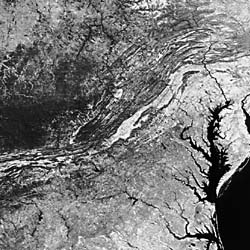 |
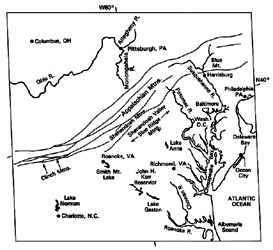 |
|---|---|
| Plate T-11 | Map |
 |
 |
|---|---|
| Plate T-11 | Map |
The daytime HCMM image records all of the central Appalachian Mountains and part of the southern Appalachians, extending 850 km from the edge of the Catskills in New York (Plate T-12) to the Pine Mountain thrust in Tennessee and North Carolina (Plate T-13). The folded rocks record the convergence of two continental plates in Pennsylvania/Permian time. Part of much of the same area, centered on central Pennsylvania and upper New York state, stands out in a Day-thermal HCMM image (Figure T-11.1) taken on September 26, 1978, in which the dark tones correlate with higher standing resistant stratigraphic units in the fold mountains that are mantled with heavy vegetation; the lenticular light-toned pattern in center right is the Wyoming Valley syncline, covered with dark wastes from anthracite mining that absorb solar energy and reradiate it at temperatures higher than the adjacent uplands. The dark northeast-pointing finger-like apophyses near the center of the thermal image (shown in more detail in Figure T-11.2, a Landsat MSS band 5 image) are gentle synclinal mountains along the north edge of the Appalachian Plateau. Spectacular large-scale trellis drainage has developed on these broad folds and persists well to the northeast of the dark "fingers."
| Figure T-11.1 | Figure T-11.2 |
|---|---|
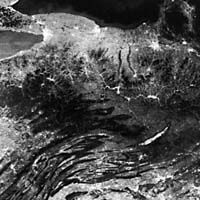 |
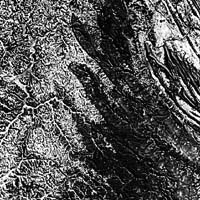 |
Both HCMM scenes highlight several of the Appalachian physiographic provinces -the fold belt consisting of the Valley and Ridge, the Blue Ridge and its eastern extension into the Reading Prong, the carbonate rocks in the Great Valley including the Shenandoah Valley in Virginia and its Pennsylvanian counterpart, and the low rolling hills of the Piedmont. The flat-lying terrain imposed on Paleozoic sediments of the Appalachian Plateau and Interior Lowlands can be seen to the northwest. To the southeast, the landscape is carved from Late Mesozoic/Cenozoic sediments of the Atlantic Coastal Plains that lap unconformably over the Piedmont. In these images, one can easily see the regional geomorphic differences between the much-eroded and rejuvenated Appalachian Mountains and the flatlands on the east and dissected plateau on the west.
The Appalachians are one of the regions from which modern ideas of tectonics and mountain-building have evolved. The concept of the geosyncline arose from studies in the 1800s of the depositional and subsequent deformational events recorded in the central Appalachians. The advent of plate tectonic concepts has modified and refined these ideas so that the Appalachians are now used as a type example for the Wilson cycle (the opening and closing of an ocean).
The Appalachians of eastern North America stretch northeast 3200 km from Alabama to Newfoundland and have an exposed width between 150 and 600 km. Before the opening of the Atlantic Ocean, the region was continuous with the Caledonides of northwestern Europe and eastern Greenland. At its southern tip in northern Alabama, it bends westward in a buried fold belt extending across to Arkansas, where it joins the Ouachita belt (plate T-14) that, in turn, extends southwestward in the subsurface to the Marathon fold belt of west Texas and northern Mexico. The illustration at the bottom of the next page is a map prepared by R. Hatcher and G. Viele (1982), outlining the subdivisions of the Appalachian orogen.
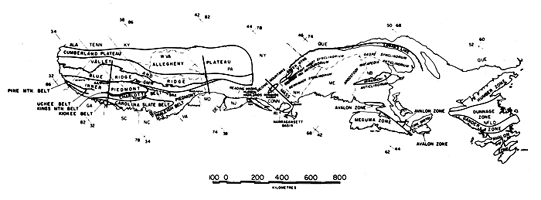 |
|---|
| Map #2 |
This map suggests that structural and age units of the Appalachians north of a hinge line in southeastern New York are different from those to the south, although there is some correlation. Pre-Late Paleozoic deformational events dominate the northern segment, and rocks are more intensely metamorphosed, where more deeply buried, and have sustained more viscous deformation than those to the south. Figure T-11.3 shows the western side of the New England Appalachians along the Green Mountains of Vermont (right side), as they abut against the Champlain Valley and the Adirondack Mountains to the west. The Green Mountains consist of Taconic thrust sheets of Lower Paleozoic eugeosynclinal metasediments carried over miogeosynclinal carbonates and other sedimentary rocks in the Champlain/Hudson lowlands. To their east are additional thrusts emplaced during the Acadian deformation. Lake Champlain lies along a fault system separating the domal uplift of the Adirondacks (an outlier of the Grenville section of the Canadian Shield (Plate T-15) from the New England Province. Faults are indicated by the linearity of the lake and associated river valleys, but erosion was certainly facilitated by the presence of Cambrian/Ordovician carbonates that underlie the lowlands. The topographic grain of the Adirondacks shows a strong structural influence in a northeast-southwest direction. Lineaments (expressed primarily as valleys) area result of erosion along fractures. Crosscutting faults are indicated by lineaments in both provinces.
Much of the terrane in New England is equivalent to that of the Piedmont; both are root zones of metamorphosed Lower to Mid-Paleozoic sediments, volcanic rocks, and plutons that have been exposed by erosion of 5 to 15 km or more of overlying rock. The Piedmont region comprises deeper continental crust that contained island-arc and arc-trench gap deposits, some parts of earlier shelf, and later foreland basin deposits, together with mélange and ophiolite suites. These were compressed and moved toward the continent (westward) as flowage nappes and overthrusts.
The Piedmont of the United States and parts of the Canadian Appalachians contain zones that represent either segments of ancient continental margins or suspect terranes (rafted in on oceanic plates or crustal fragments detached from the continental crust elsewhere and transported laterally along transcurrent faults) that eventually accreted to the orogen. There are abrupt differences in lithology, stratigraphic sequence, and tectonic style across the boundaries of these terranes with adjacent assemblages. A prominent band of ophiolites extends from Atlanta to southeastern Quebec in the western Piedmont (mainly to the east of the Blue Ridge and the surface traces of the thrust sheets). This may mark suturing of oceanic sediment and upper basaltic crust along a subduction zone.
Like many other orogenic belts, the Appalachians have a long complex history. It has been interpreted in terms of the Wilson Cycle, the opening and closing of oceans (Condie, 1982; Windley, 1984, Ch. 12) as follows: (1) Late Proterozoic rifting of Laurasia; (2) initiation of subduction in Late Precambrian; and (3) closure of the proto-Atlantic (or Iapetus) Ocean by the Middle Devonian. A more recent interpretation (Williams and Hatcher, 1982) accounts for the several orogenic events (Taconic (450 to 500 Ma ago), Acadian (350 to 450 Ma), and Alleghenian (250 to 300 Ma)) by the accretion of several terranes to the continental margin, culminating in the closure of the Atlantic by the end of the Paleozoic as the African and North American plates collided. Each orogenic event involved folding and thrusting.
The thrust sheets that characterize Appalachian tectonics are mainly décollements in which older sequences override younger rocks. The thrusting of folds and their westward transport is the response of supracrustal rock to subduction of lower crust. The entire allochthonous sequence slides over basement rocks along one or more thrust zones. Most thrust planes parallel bedding in low-viscosity rocks such as shale (particularly the Mid-Cambrian Rome Formation) and salt beds. Individual thrust plates imbricate in slices bounded by high-angle surface-reaching reverse faults that change into lower angle thrusts with depth. Sny- and post-orogenic intrusions cut the plates, especially in the Piedmont.
| Figure T-11.3 | Figure T-11.4 |
|---|---|
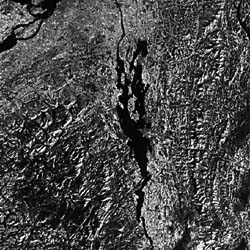 |
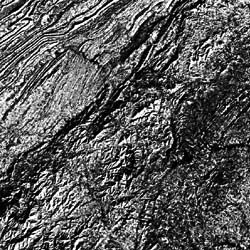 |
The folded Valley and Ridge Province is part of foreland and miogeoclinal sedimentary sequences. Deformation in this province grades from thrusts and tight to overturned folds in the east to more open, gently plunging folds to the west. The western side of this fold belt is bounded either by a thrust zone or by an escarpment that separates the steep dips of the fold belt from the gently warped, generally westward-dipping Upper Paleozoic strata of the plateau. The Appalachian (Allegheny + Cumberland) Plateau to the west contains mainly Mississippian to Permian beds that were uplifted without notable deformation.
The fold belt itself lies within a series of thrusts carried up onto the continent during the final closing of the Iapetus (pre-Atlantic) ocean as the African plate converged on the North American plate. Although earlier orogenic events during the Taconic (Ordovician) and Acadian (Devonian) stages of Appalachian history had affected the region, the activity that produced the folding we see today happened during the Alleghenian (Permian) orogeny. All three orogenies produced slices of basement and overlying sedimentary crust that moved as allochthons along decollements (slip zones) in several lower viscosity units (e.g., the Rome Formation in the southern Appalachians). Foreshortening of the crust during the Alleghenian orogeny amounted to 60 to 80 km or more.
| Figure T-11.5 |
|---|
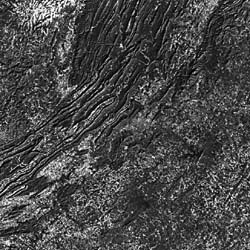 |
The Appalachian landscapes clearly demonstrate the relation of tectonics and structure to geomorphology. The topographic expression of four structural units is readily apparent in the low-Sun-angle Landsat view of the southern Appalachians of Tennessee/North Carolina around Asheville and the Great Smokies (Figure T-11.4). The Valley and Ridge fold belt (upper left corner) shows the effects of differential erosion on beds of differing hardness. The long linear ridges are etched out of steeply dipping sandstone units that are resistant to erosion. The broad exposure of carbonates in the Great Valley, just southeast of the fold ridges, reveals the continuation of the strong folding, but the more uniformly resistant lithology gives rise to much more subdued, low-relief ridges whose zig-zag patterns reveal tight plunging folds. Diagonally across the scene is the mountainous terrain (including the Great Smokies) that is an extension of the Blue Ridge of Virginia. This province is bounded on the southeast by the Brevard fault zone that separates it from the western Piedmont (lower right corner), a complexly dissected terrain marked by low hills grading to rolling country farther eastward.
Figure T-11.5 shows still another segment of the central Appalachians, centered on Roanoke in western Virginia. Here also, the Valley and Ridge fold belt is conspicuous. To the south, the Blue Ridge is discontinuous. North of Roanoke, where it is more coherent, it helps to enclose the southern end of the Shenandoah Valley. Isolated linear ridges in the Piedmont define its main structural trend. In West Virginia, the Appalachian Plateau is well dissected with rugged topography, generally high-relief decreasing westward, narrow valleys, and closely spaced interfluves. (See Plate F-26.) The New River drains the Plateau here before cutting across water gaps in the folded Appalachians. (NMS) Additional References: Bird and Dewey (1970), Harris and Bayer (1979), Hatcher and Viele (1982), Hunt (1974, Ch. 11), King (1977, pp. 522-531), Suppe (1985), Williams and Hatcher (1982). HCMM 570-17380-1, November 17, 1979.
Continue to Plate T-12| Chapter 2 Table of Contents| Return to Home Page| Complete Table of Contents